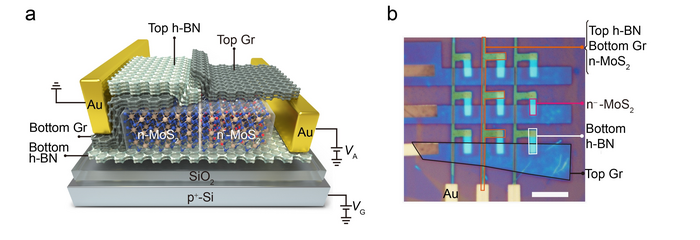A photodetector is an optoelectronic device that can identify optical signals and transform them into electrical signals. Examples of photodetectors encompass photodiodes, phototransistors, and photoconductors.
 a. Schematic of a photon-controlled diode fabricated by sandwiching an h-BN layer between an n/n− MoS2 junction and a SiO2/p+-Si back-gate, using bottom/top graphene as cathode/anode and a top h-BN as protecting mask. b. Optical photograph of the fabricated array using the photon-controlled diode as a unit. (scale bar: 10 μm). Image Credit: ©Science China Press
a. Schematic of a photon-controlled diode fabricated by sandwiching an h-BN layer between an n/n− MoS2 junction and a SiO2/p+-Si back-gate, using bottom/top graphene as cathode/anode and a top h-BN as protecting mask. b. Optical photograph of the fabricated array using the photon-controlled diode as a unit. (scale bar: 10 μm). Image Credit: ©Science China Press
While there are many multiple kinds of photodetectors with various mechanisms and structures, the demonstrative behavior can be shortened as a limited set: the output current of a photodiode changes from corrected to a fully-on state after illumination, whereas the output current of a photoconductor or a phototransistor shifts from fully-off to fully-on state.
From the standpoint of signal change behavior, a new device that alters the output current from fully-off to rectified state should exist, and it may play a significant role in potential optoelectronic systems like high-precision imaging, optical logic, and data processing.
For example, rectification controlled by light can prevent the crosstalk issue of photodetector arrays without the use of selectors, allowing the array’s integration to be improved even further.
Dong-Ming Sun Group from the Institute of Metal Research, Chinese Academy of Sciences, recently proposed a new device called a photon-controlled diode, which can modify the output current from a fully-off state to a corrected state after illumination for the very first time, resulting in an anti-crosstalk photo memory array without the use of selectors. The paper was published in National Science Review.
Researchers use lateral n/n− molybdenum disulfide (MoS2) junction as a channel, graphene as contact electrodes, and hexagonal boron nitride (h-BN) as a photogate layer material to fabricate the photon-controlled diode, which is an n/n− MoS2 junction implanted between two graphene/MoS2 Schottky junctions at the cathode and the anode.
Organized by light, the Schottky junctions defeat or permit the rectification performance of the n/n− junction, so that the output current of the photon-controlled diode can alter from fully-off to rectified state.
The light-to-dark rectification ratio can reach over 106. Its responsivity as a photodetector exceeds 105 A/W while increasing the thickness of the photogating layer shifts the device’s behavior to a multipurpose photomemory with the greatest nonvolatile resonance of 4.8 × 107 A/W and the longest retention time of 6.5 × 106 seconds reported so far.
Employing the photon-controlled diodes as pixel units, a 3×3 photo memory array is fabricated without consuming any selectors, presenting no crosstalk as well as functions of wavelength and power density selectivity. This research clears the path for the development of new high-integration, low-power, and smart optoelectronic systems.
The National Natural Science Foundation of China provided funding for this study.
Journal Reference:
Feng, S., et al. (2022) A photon-controlled diode with new signal-processing behavior. National Science Review. doi.org/10.1093/nsr/nwac088.